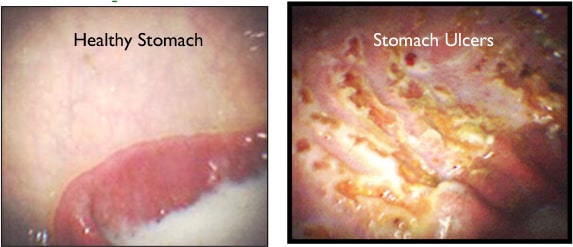Part of the reason horses get stomach ulcers is because of the anatomy of their stomach, which has a nonglandular covering in the top 1/3 that has minimal protection from stomach acids and 80% of ulcers occur here. The lower 2/3 of the stomach is glandular and secretes hydrochloric acid for digestion but also mucous and bicarbonate that provide protection from the acid. As horses are continual grazers, the stomach is constantly producing acid, which is the primary reason for ulcer development.
Causes of stomach ulcers include feeding high grain diets, stress, (e.g. illness, transport, new environments), intermittent feeding, intensive training and treatment with nonsteroidal anti-inflammatory drugs, such as bute. Signs of ulcers in horses include picky eaters who may prefer hay and grass to their hard feed, mild colic, discomfort when doing up the girth and riding, diarrhoea, weight loss, attitude change, poor hair coat and poor performance.
Stomach ulcers can only be diagnosed in horses by gastroscopy, that is, passing a long tube with a camera at the end up the nose, down the oesophagus and into the stomach to look inside. No other tests are reliable. Treatment is usually successfully achieved by using drugs that inhibit the stomach acid production or coat the ulcers, and by changes in the horse’s environment to reduce stress. Usually we don’t see complete improvement until 4 to 6 weeks of treatment and some animals require preventative dosing around periods of stress.
Below are images from a healthy foal’s stomach and a very sore stomach with ulceration in the unprotected nonglandular part. Ouch!!

